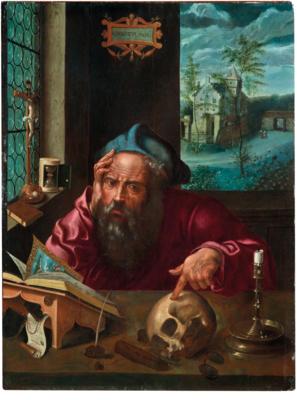Workshop of Pieter Coecke van Aelst

(Aalst 1527–1550 Brussels)
Saint Jerome in his study,
oil on panel, 70 x 53 cm, framed
We are grateful to Peter van den Brink for suggesting the attribution for the present painting on the basis of a photograph. He dates this work to circa 1550.
Technical analysis by Gianluca Poldi:
The work is painted on a light soft wood panel, made of two vertical boards about 15 mm thick, with two horizontal crossbars: not the typical Flemish support of oak. But the pigments and painting technique are completely coherent with Flemish tradition, with some peculiarities that we are going to illustrate. We exclude, looking to the painted surface and to IR reflectograms, that the pictorial film was detached from a previous support and applied to the present one.
Pigments and mixtures, detected by reflectance spectrometry and digital microscopy, include azurite – mixed with lead white – as the only employed blue in blue sound areas (sky, hat, base of the “COGITA MORI” inscription, the painted miniature with the Crucifixion) as well as in the green hues of the vegetation. A beautiful carmine-type red lake (Cochineal?) is mixed with yellow grains in the robe, while the flesh tones are obtained admixing lead white to vermillion and azurite, as some sixteenth-century Italian painters scarcely ever did, to reach a pink-greyish tone. Azurite was also used in the brown of the table, mixed with a finely grinded brown, presumably rich in organic component (like Kassel earth). A pink-brown ground can be seen inside the craquelure at high magnification and also under the clouds at unaided eye: quite uncommon, it must be very thin, because it appears to be transparent to IR radiation also in narrow Near Infrared bands (850–1000 nm), allowing to see the wood texture under it and the signs of its polishing.
No evident traces of underdrawing were detected, if not for a few areas, despite the good transparency to IR: probably an IR-transparent medium was used. The Crucifix in front of the window was painted almost at the end, over the partially coloured window.
The quality of details is extremely high, as the objects above the window shelf and around the lectern show. The quite anomalous support could suggest the painting was done outside Flanders and outside North European regions, or simply that a different panel was preferred for some unknown reason.
Technique and pigments are coherent with (mid-late?) 16th century and also early 17th century Flemish/Northern practice.
Specialist: Mark MacDonnell
 Mark MacDonnell
Mark MacDonnell
+43 1 515 60 403
old.masters@dorotheum.com
10.11.2022 - 17:13
- Estimate:
-
EUR 20,000.- to EUR 30,000.-
- Starting bid:
-
EUR 20,000.-
Workshop of Pieter Coecke van Aelst
(Aalst 1527–1550 Brussels)
Saint Jerome in his study,
oil on panel, 70 x 53 cm, framed
We are grateful to Peter van den Brink for suggesting the attribution for the present painting on the basis of a photograph. He dates this work to circa 1550.
Technical analysis by Gianluca Poldi:
The work is painted on a light soft wood panel, made of two vertical boards about 15 mm thick, with two horizontal crossbars: not the typical Flemish support of oak. But the pigments and painting technique are completely coherent with Flemish tradition, with some peculiarities that we are going to illustrate. We exclude, looking to the painted surface and to IR reflectograms, that the pictorial film was detached from a previous support and applied to the present one.
Pigments and mixtures, detected by reflectance spectrometry and digital microscopy, include azurite – mixed with lead white – as the only employed blue in blue sound areas (sky, hat, base of the “COGITA MORI” inscription, the painted miniature with the Crucifixion) as well as in the green hues of the vegetation. A beautiful carmine-type red lake (Cochineal?) is mixed with yellow grains in the robe, while the flesh tones are obtained admixing lead white to vermillion and azurite, as some sixteenth-century Italian painters scarcely ever did, to reach a pink-greyish tone. Azurite was also used in the brown of the table, mixed with a finely grinded brown, presumably rich in organic component (like Kassel earth). A pink-brown ground can be seen inside the craquelure at high magnification and also under the clouds at unaided eye: quite uncommon, it must be very thin, because it appears to be transparent to IR radiation also in narrow Near Infrared bands (850–1000 nm), allowing to see the wood texture under it and the signs of its polishing.
No evident traces of underdrawing were detected, if not for a few areas, despite the good transparency to IR: probably an IR-transparent medium was used. The Crucifix in front of the window was painted almost at the end, over the partially coloured window.
The quality of details is extremely high, as the objects above the window shelf and around the lectern show. The quite anomalous support could suggest the painting was done outside Flanders and outside North European regions, or simply that a different panel was preferred for some unknown reason.
Technique and pigments are coherent with (mid-late?) 16th century and also early 17th century Flemish/Northern practice.
Specialist: Mark MacDonnell
 Mark MacDonnell
Mark MacDonnell
+43 1 515 60 403
old.masters@dorotheum.com
|
Buyers hotline
Mon.-Fri.: 10.00am - 5.00pm
old.masters@dorotheum.at +43 1 515 60 403 |
| Auction: | Old Master Paintings II |
| Auction type: | Online auction |
| Date: | 10.11.2022 - 17:13 |
| Location: | Vienna | Palais Dorotheum |
| Exhibition: | 22.10. - 09.11.2022 |
